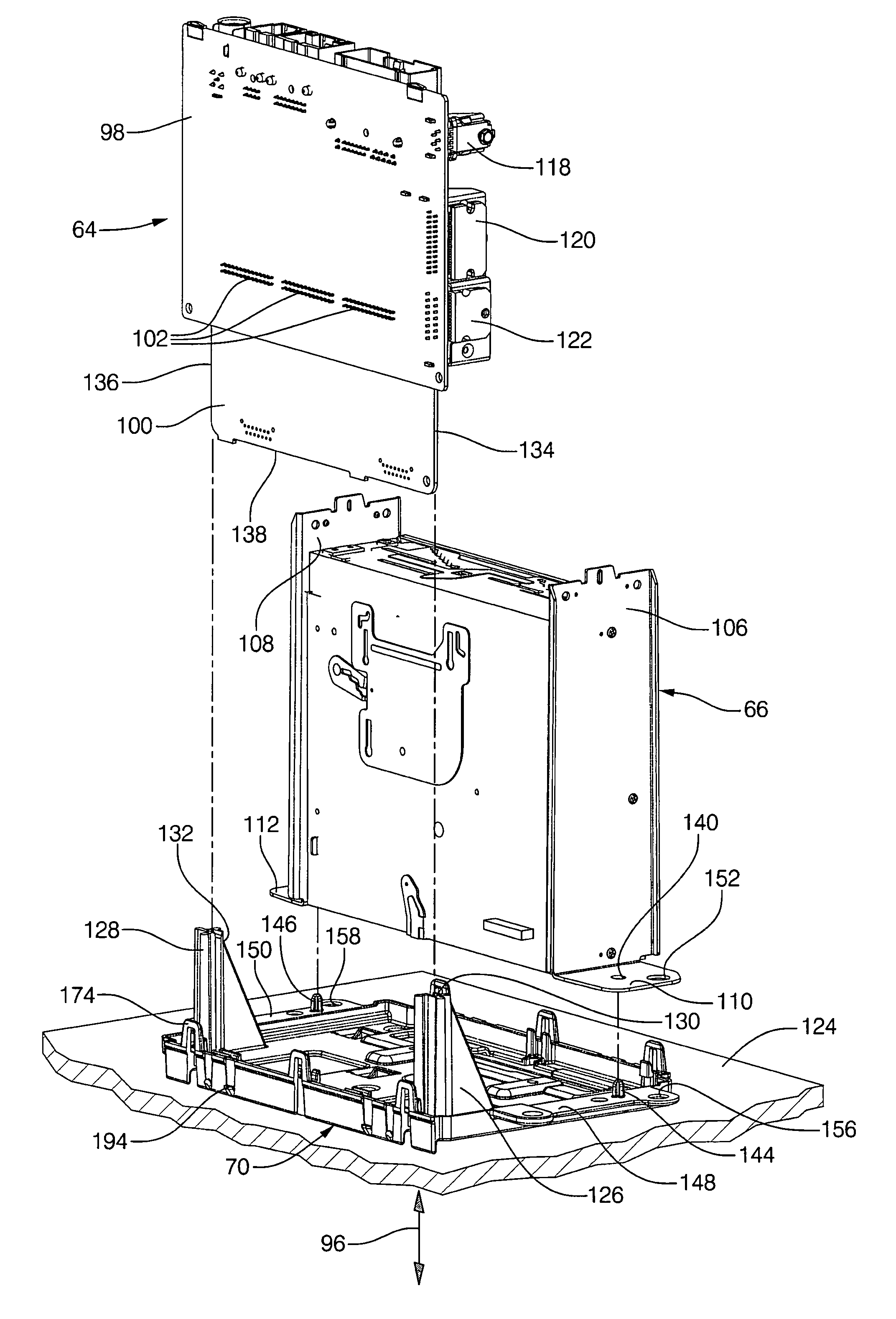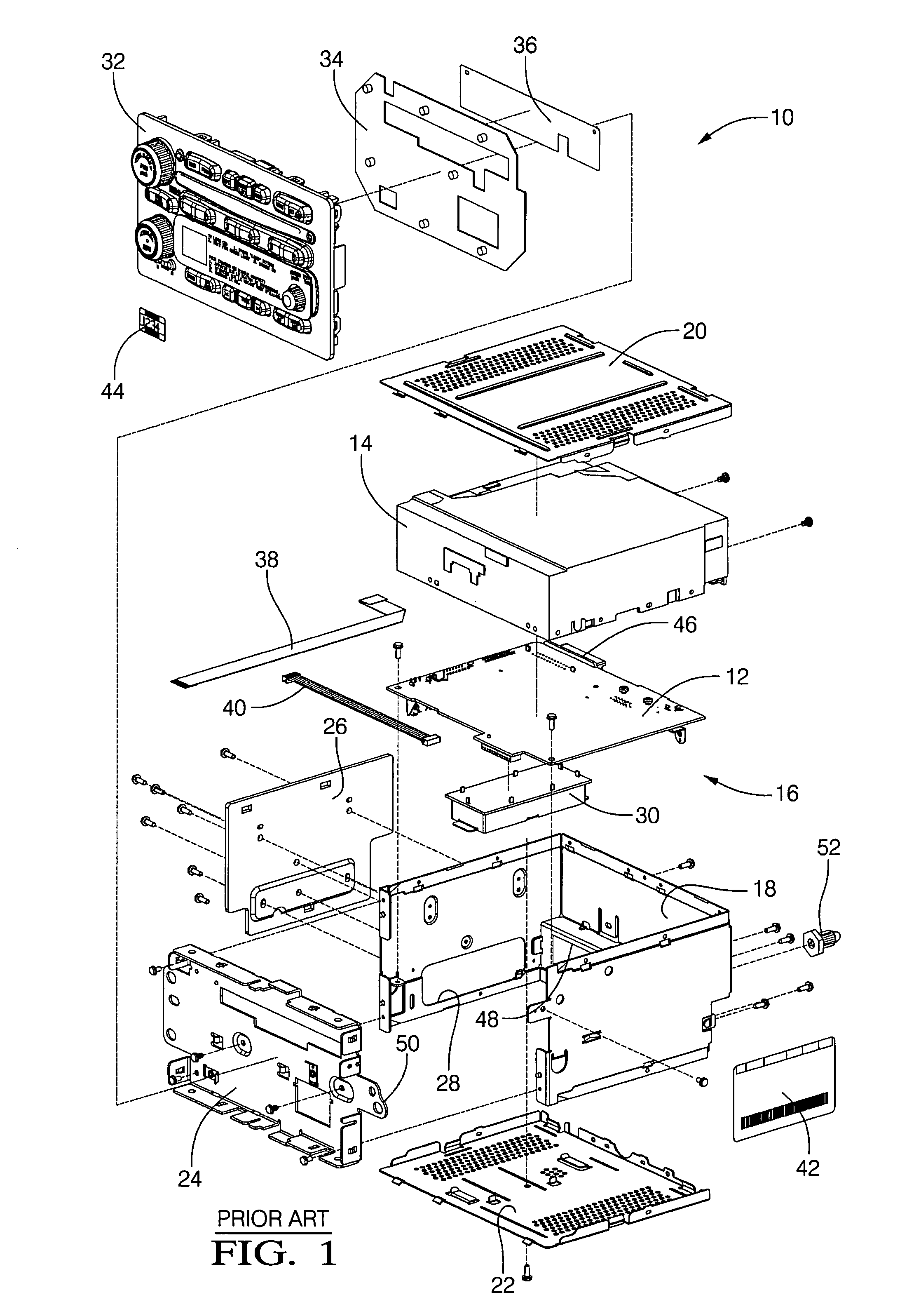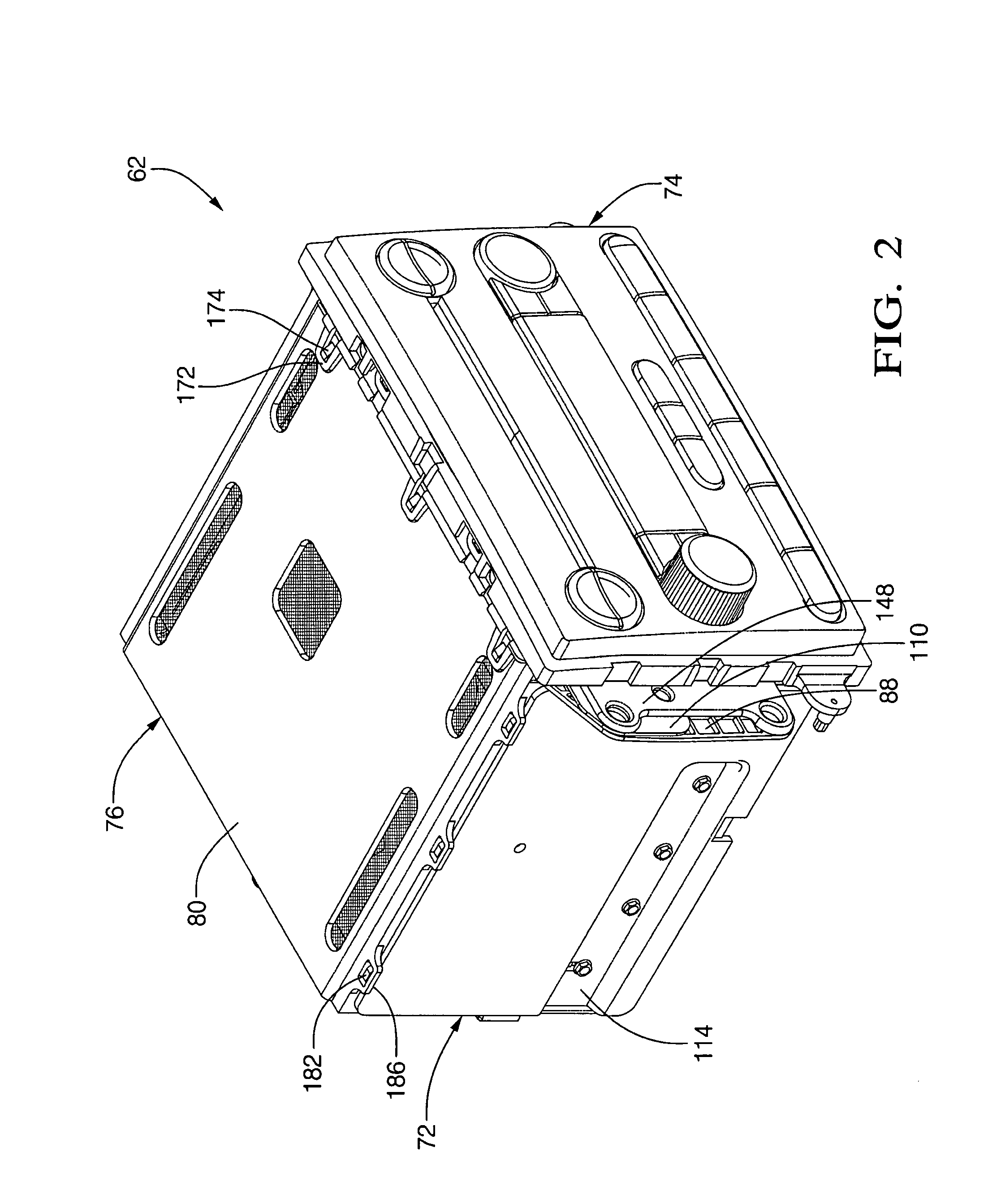The use of such fasteners can have numerous drawbacks, particularly in a high volume production setting.
When threaded fasteners are used to assemble an electrical device, the assembly
cycle time can be very long especially in high volume production.
Furthermore, using threaded fasteners presents a risk of any one of the following upstream failures occurring: stripping of
fastener threads; insufficient torque resulting in an unseated
fastener; excessive torque resulting in
distension / deformation of the
fastener or adjacent electrical components; installation of the wrong fastener type or size;
foreign object damage due to fasteners and / or
metal shavings dropping onto the assembly and / or subassembly; and stripping of the head of the
threaded fastener.
Also, a fastener installation tool such as a driver and bit can slip off the fastener and
impact an electrical component resulting in a damaged assembly.
If self-tapping fasteners are used, the process of driving the self-tapping fasteners into sheet
metal often causes shavings of sheet
metal to disperse into the assembly.
Such shavings have been known to cause electrical failures, such as shorts or corruption of
magnetic components that can permanently damage the product.
Fasteners further require an additional inventory burden on the
production line in that the
production line must be continuously stocked with part numbers (fasteners) other than the integral components that add value to the assembly.
Such fixtures can be very complex, and the use of such fixtures usually requires extra handling of both the subassembly and of the resulting assembly thereby adding to the
production cycle time and potentially compromising quality of the final product.
Unfortunately, with the density of the metal, the
disadvantage of added weight is a
side effect of the typical construction.
In a vehicle, added weight impacts fuel economy, as well as other hidden costs during assembly that can effect the cost of the product, like sharp edges of metal can be a potential
hazard for
assemblers in the manufacturing
plant as well as added weight can limit the packaging of multiple parts in containers for inter and outer
plant distribution.
For example, excessive temperatures can cause delicate electrical leads to fail or insulating materials to melt, thereby causing a
short circuit resulting in damage to, or even failure of, the entire electrical device.
The use of such fasteners can have numerous drawbacks, particularly in a high volume production setting.
Or, a stripped or improper type of fastener may provide an insufficient clamping force.
Such fixturing can be very complex and use of such fixturing usually requires extra handling of both the component and of the resulting assembly, thereby adding to the
production cycle time and potentially compromising quality of the final product.
When threaded fasteners are used, the assembly
cycle time can be very long, especially in high volume production.
If self-tapping fasteners are used, the process of driving the self-tapping fasteners into metal often causes metal shavings to disperse into the assembly.
Such shavings have been known to cause electrical failures that can permanently damage the product.
Static electricity (
electrostatics) is created when two objects having unbalanced charges touch one another, causing the unbalanced charge to transfer between the two objects.
Similar problems may occur when using DVD and other
magnetic media and disc players.
Accordingly, problems with the drainage of a static
electric charge impacting sensitive electronic components continue to persist.
Unfortunately, each of the buttons has required individual fabrication and decoration, which significantly increases the total cost of an end product so designed.
Further, as the individual buttons are actuated, they can produce a squeaking
noise due to the fact that each of the individual buttons includes a number of posts that mate with integrally formed guides in the housing.
Various automotive accessories, such as an automotive radio, also receive inputs from rocker switches, which, similar to button switches, have been painted and
laser trimmed and also may create
noise when a user actuates the rocker switch as the switch may engage a separate housing or trim plate.
Further, the increased temperature may place undesirable thermal stress on the display components.
Unfortunately, these systems require additional, cumbersome circuitry for turning the button light sources on and off.
However, because this location of the
light pipe is typically shared by other electrical components and mechanical structures (i.e. button bodies, potentiometers, plastic ribs, LCD displays, etc.), the design of the
light pipe may become complex, which may affect the efficiency of the
lighting system.
Accordingly, a final design of the
light pipe has often included complex structures that weave between the electrical components and mechanical structure.
Losses in collimation also increase the difficulty in directing light exiting the light
pipe to the specific areas of the display panel.
The complexity of such light pipe designs makes
computer simulation difficult and
time consuming, which lends to prevention of design optimization by means of iterative prototyping and expensive design cycles drawn out with
proof of concept often being delayed until injection molded light pipe prototypes can be produced.
In this regard, cost and durability factors can be significant in the final selection of the switch mechanisms to be utilized.
For example some of the switch mechanisms provide excess freedom of movement, have undesirable
noise problems, are too expensive, have alignment problems in the socket or housing in which they are positioned, do not operate with the requisite tactile “feel”, or are simply too difficult to operate for the desired function.
The auxiliary jack allows playing the music, but does not necessarily allow for player control through the radio.
The problems with the glove box approach are the potential for damage to the device from other contents in the glove box, and the cable connection offers no flexibility for connecting to another device.
Damage may occur to the cable as well through normal use.
The auxiliary jack method allows more flexibility for devices, but limits the control and may incur damage through
impact while a plug is connected.
Some aftermarket radios offer a
USB (Universal Serial Buss) port on the
front panel thereof, but may also incur damage due to the potential leverage on the face of the unit when a
flash memory is connected, not to mention vehicle occupant
impact issues resulting from braking and collisions.
Furthermore, connection interfaces open to the vehicle passenger compartment environment risk system damage from foreign objects and air-borne
contamination, not to mention being aesthetically unattractive.
The rapidly changing customer market has initiated a drive to feature content on OEM (
original equipment manufacturer) supplied radios for automobiles to provide those wants and that has an impact on interchangeability and potential safety issues.
 Login to View More
Login to View More 


